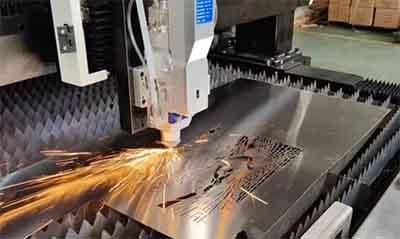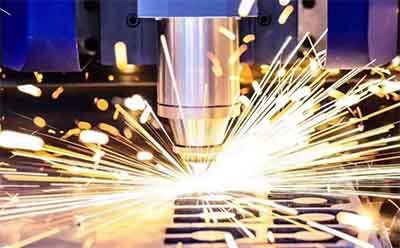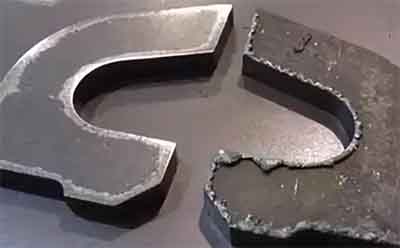
Laser cutting quality of laser cutting machine is affected by many different factors, which are very complex. The working principle of laser cutting machines is mainly the interaction between laser and materials, and the interaction process is mainly divided into two phenomena: micro and macro. Microscopic phenomena mainly refer to quantum reaction processes, while macroscopic phenomena include material absorption, reflection, refraction, energy conversion and transmission of lasers. In addition to the characteristics of the material itself, there are also some hardware factors that affect it. Let's take a look together.

There is a significant relationship between the incision width of laser cutting and the diameter of the focused spot. Due to the fact that the power density and energy density of laser irradiation are related to the diameter of the laser spot, in order to obtain a larger power density and energy scale, in laser cutting processing, the diameter of the spot should be as small as possible.
The magnitude of laser power directly affects the thickness of the steel plate that can be cut. The higher the power, the thicker the material that can be cut. In addition, it also affects the dimensional accuracy of the workpiece, the width of the cutting seam, the roughness of the cutting surface, and the width of the heat affected zone.
Laser power has a significant impact on cutting speed, seam width, cutting thickness, and cutting quality. The power level is determined by the material characteristics and cutting mechanism. Materials with high melting points (such as alloys) and high surface reflectivity (such as copper and aluminum) require higher laser power.
For example, a 1500W Metal Sheet Fiber Laser Cutting Machine cannot achieve the work of a 6000W laser cutting machine. Many times, if you find that the cutting effect is not ideal, it is very likely that you have chosen the wrong laser model.
In laser cutting processing, there is a laser power that achieves the best cutting quality. Under this laser power, there may be phenomena of incomplete cutting or slag hanging. Above this power, it will overheat.

Cutting speed has a significant impact on cutting quality. The ideal cutting speed will result in a relatively smooth line on the cutting surface, smooth material cross-section, and no burrs. When the auxiliary gas pressure and laser power are constant, there is a non-linear inverse relationship between the cutting speed and the cutting seam width. If the cutting speed is too slow, it is easy to cause material overfusion, the cutting seam becomes wider, the heat affected zone increases, and even the workpiece overfusion. Cutting too fast can cause the material to fail to cut through, causing sparks to splash, producing slag in the lower half, and even burning the lens.
The aperture of the nozzle and the distance between the nozzle outlet and the material surface can all affect the cutting effect.
The focus position directly affects the width of the incision, cross-sectional roughness, and adhesion of waste residue. The different focal positions result in different beam diameters and focal depths on the surface of the processed material, leading to changes in the shape of the cutting seam and affecting the flow of processed gas and molten metal within the cross-section.
The focus position is the distance from the laser focus to the surface of the workpiece, which directly affects the roughness of the cutting surface, the slope and width of the cutting seam, and the adhesion status of the molten residue. If the focus position is too advanced, it will increase the heat absorbed by the lower end of the workpiece being cut. At a certain cutting speed and auxiliary air pressure, it will cause the material being cut and the melted material near the cutting seam to flow in a liquid state on the lower surface. After cooling, the melted material will adhere to the lower surface of the workpiece in a spherical shape. If the position lags behind, the heat absorbed by the lower end face of the material being cut will decrease, so that the material in the cutting seam cannot completely melt, and some sharp and short residues will adhere to the lower surface of the board. Usually, the focus position should be on the surface of the workpiece or slightly lower, but different materials require different requirements. When cutting carbon steel, the cutting quality is better when the focus is on the surface of the plate. When cutting stainless steel, the focus should be around 1/2 of the plate thickness for better results.
Material cutting requires the use of auxiliary gas, mainly gas pressure and gas type, both of which can affect the roughness of the cutting section and the generation of slag.
In laser cutting processing, auxiliary air pressure plays a role in blowing off slag, cooling materials, and assisting combustion. Auxiliary gases include oxygen, compressed air, nitrogen, and inert gases.
Oxygen can participate in metal combustion and improve cutting efficiency, making it suitable for cutting most metals; Inert gases and air are suitable for cutting certain metal materials (such as aluminum alloys) and non-metallic materials, which can prevent material combustion.
If the auxiliary gas pressure is too high, eddy currents will appear on the surface of the material, weakening the ability to remove molten materials, leading to widening of the cutting seam and rough cutting surface; If the air pressure is too low, the molten material cannot be completely blown away, and slag will adhere to the lower surface of the material. Therefore, the auxiliary gas pressure should be adjusted during cutting to obtain the best cutting quality.

Laser cutting of the cross-section will form vertical patterns, and the depth of the patterns determines the roughness of the cutting surface. The shallower the patterns, the smoother the cutting cross-section. Roughness not only affects the appearance of edges, but also affects friction characteristics. In most cases, it is necessary to minimize roughness, so the shallower the texture, the higher the cutting quality.
Cutting carbon steel generally encounters problems such as insufficient brightness of thin plate sections and rough thick plate sections.
Generally speaking, a 1000W laser can cut carbon steel up to 4mm in brightness, with 2000W being 6mm and 3000W being 8mm.
The formation of burrs is a very important factor determining the quality of laser cutting, as the removal of burrs requires additional work, so we can intuitively judge the quality of cutting based on the quantity and degree of burrs.
Firstly, check if there are any issues with the laser output, whether the light spot is very round, and whether the light spot is coaxial with the center hole of the nozzle. A circular light spot indicates that the transverse distribution of laser energy is uniform, and the energy distribution of the light points formed after being focused by the lens is also more uniform, which is the key to good cutting quality; The better the coaxiality between the light spot and the nozzle center hole, the better the cutting quality.
Secondly, check the lenses and lenses during the laser transmission process for small particles, dust, splashing residue, and other objects that affect the cutting quality. Check the lenses for small cracks that are not easily visible to the naked eye, all of which can affect the transmission of laser power.
Only after checking the above two points can we determine whether the laser itself is in good condition. Then comes the adjustment of process parameters.
The burrs generated after laser cutting of stainless steel have a certain hardness, which is very time-consuming to remove and also affects the aesthetics of the workpiece. It is best to address the root cause: the purity of the gas is crucial, and it is best not to use steel cylinder gas. Secondly, the cutting parameters should be adjusted to the optimal level, with multiple adjustments made to the air pressure flow rate, focal length cutting speed, etc.
Equipment+gas+parameters (adjusted to optimal)=cutting workpiece with less burrs
In laser cutting, the area near the incision is heated. At the same time, the structure of the metal undergoes changes. For example, some metals may harden.
Depression and corrosion have adverse effects on the surface of the cutting edge, affecting its appearance, and they occur in cutting errors that should generally be avoided. If cutting causes the component to heat up sharply, it will deform.
This is particularly important in fine machining, as the contours and connecting pieces here are usually only a few tenths of a millimeter wide. Controlling laser power and using short laser pulses can reduce component heating and avoid deformation.
Laser cutting is a complex process, and it is often difficult to cut through during the cutting process. There are many reasons why the sample cannot be cut through, and the most common one is the decrease in laser power or the aging of the lamp tube, which results in insufficient energy of the laser beam and the inability to cut through the sample. Excessive cutting speed, damage to the focusing lens, poor focusing effect, incorrect optical path, and unstable voltage are all reasons why laser cutting cannot penetrate. Of course, there are also many factors that cause the sample to not cut thoroughly, such as problems with the material itself, insufficient pressure of auxiliary gas, and poor cooling effect of water turbidity in the cooling system.
- It is necessary to reduce the cutting speed appropriately, clean contaminated mirrors in a timely and reasonable manner, and replace focusing lenses.
- For the issue of incorrect optical path, the optical path can be readjusted and the focal length adjusted until the laser strikes a spot concentric with the center of the nozzle on the paper.
- When cutting copper and aluminum, it is best to polish its surface in advance or apply light absorbing materials to address the issue of high reflectivity.
- Regularly clean the foreign objects inside the nozzle, increase the pressure of the auxiliary gas, and replace the distilled water in the cooling system in a timely manner.
The color change near the incision of stainless steel during cutting is mainly due to the oxidation of the material at high temperatures. Stainless steel is not only a high-temperature resistant material, but also an insulation material due to its poor thermal conductivity. When we cut these materials, due to their slow thermal conductivity, higher temperatures are generated and accumulated near the incision, resulting in oxidation of stainless steel in the air at high temperatures. The oxidation depth varies with different temperatures, resulting in different colors.
In addition, slow cutting speed, incorrect focus, and low gas purity can all cause surface discoloration of the sheet.
- The material is too hot, cool the material.
- The feed rate is too low, increase the feed rate.
- The material is not aligned with the focal length of the laser head. Use a locator to test and adjust the focal length.
- The pressure is too low, increase the pressure.
- Nitrogen contains oxygen impurities, so use high-quality and high-purity nitrogen.
Not all materials are suitable for cutting with laser cutting machines. Laser cutting machines generate high temperatures during the process of cutting plates, which can sometimes cause chemical reactions in the plates, leading to material deterioration. For example, when cobalt plates used as additives in steel smelting are cut into small pieces, a laser cutting machine cannot be used, but a plate guillotine shearing machine should be used in this case for mechanical cutting.
Select appropriate cutting equipment according to the industry requirements that need to be applied after cutting the board. In sheet metal cutting equipment, in addition to fiber laser cutting machines, plate shearing machines, hydraulic punches, turret punches, and waterjet cutting machines are also very popular.
There are many factors that affect the cutting quality of laser cutting machines. By fully understanding the various factors in the cutting process of laser cutting machines, one can find a process path to improve the surface quality of processed materials and improve the surface quality of processed materials.
Laser Cutting Automatic Production Line
Other related information about laser cutting: